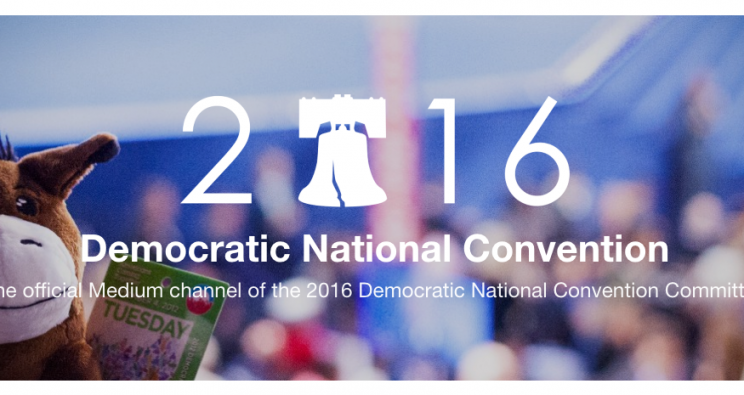Live streams, social platforms and apps, oh my: The DNC & RNC quests for digital engagement

After formally introducing Sen. Tim Kaine as her running mate at a rally in Virginia last weekend, Democratic presidential candidate Hillary Clinton took to the interactive online publishing platform Medium to offer her supporters a more detailed explanation of how she made her decision.
On Monday, as the 2016 Democratic National Convention kicked off in Philadelphia, Kaine responded to Clinton with a Medium post of his own.
“I wanted to take a moment to tell you a little bit more about myself ,” wrote the newly minted vice presidential candidate. “And bear with me, since I know you might not have even heard of me before Friday!”
This online interaction between the Democratic Party’s leading White House contenders was not only emblematic of Medium’s growing presence in the political sphere, but of the crucial role new technology and communication platforms have played in making 2016 the most accessible political convention cycle in history.
DNC Chief Innovation Officer Andrew Binns said he’s personally observed the dramatic impact the prevalence of social media and mobile devices has had on the way parties and politicians interact with voters since his first Democratic convention in 2004 — and even since 2012.
“Back then we could just broadcast things out,” Binns said. “Now we can actually engage with people.”
At 32, Binns said he’s the youngest senior staffer on the convention committee by about 15 to 20 years. But compared with the rest of the DNC’s tech team, which boasts an average age of about 27, he’s the old-timer.
Under Binns’ direction, his young team looked to their own media diets, and those of their peers, to create a convention that could accommodate the wide variety of ways people now consume content. Stuff like: Snapchat, Twitter, Instagram and YouTube.
For example, Binns said, “I watch TV on an Internet-connected device. I’m a cord cutter.”
As a result, in addition to establishing a presence for the DNC on leading social media networks like Instagram, Twitter and Facebook, Binns and crew worked to broadcast the 2016 convention over more than a dozen platforms, including the recently launched DNC mobile app, popular streaming services like Apple TV and Roku, as well as regular television networks.
“The idea is that we want to make sure people can get our content anytime, anywhere, through any device,” Binns said. As a result, “more people [will be] engaged in the process.”
Engagement was equally important to the RNC’s 29-year-old digital director Samantha Osborne, who similarly spearheaded the use of several social media platforms as well as the release of a brand-new mobile app with live-streaming capabilities in advance of last week’s Republican National Convention.
“Media is changing and we have to adapt to reflect that,” Osborne told Yahoo News ahead of the GOP convention in Cleveland. “We are going where the people are.”
It was with this shared mission in mind that both parties’ digital teams also chose to use the four-year-old platform Medium — which promotes user interaction — to share things like event schedules, speaker profiles and dispatches from delegates on the convention floor.
(Yahoo News has also used Medium to cross-publish content on the conventions.)
“Medium really is a good place for context building,” Matt Higginson, Medium’s head of government affairs, told Yahoo News on his way into the DNC convention center in Philadelphia Monday.
While “both parties used [Medium] as a way to do some storytelling in the lead-up to convention,” Higginson pointed to posts like one written by Republican Sen. Jeff Flake while in Cleveland, imploring members of his party to refocus their attacks on Hillary Clinton, as an example of how he wants political leaders to use the site as a forum for conversation.
“I think we’ll probably see a lot more of that out of the DNC,” Higginson predicted.
The Democratic convention is also using its Medium channel to publish copies of speakers’ prepared remarks ahead of broadcast — giving the public advance access to information once previously reserved for the press.
This tactic is exactly what put Medium on the mainstream media’s radar back in January when, moments before President Obama was to deliver his State of the Union address, the White House broke with tradition and posted his entire speech on Medium.
Since then, Medium has actively pursued the prose of the heaviest politics hitters by presenting itself as a modern-day alternative to the old-school op-ed page.
“Medium provides a level of intimacy that has been lost in politics,” Higginson wrote in a recent post aimed at making the case for why politicians and campaigns should embrace the platform.
Medium does not make its user demographics public. But while Higginson said Medium’s readers “skew young and educated,” he emphasized that, perhaps more significantly, the site draws an “audience who wants to have their preconceived notions and biases challenged or enhanced.”
For the DNC, digital director Kelli Klein explained, the decision to use Medium once again boiled down to engagement.
“We knew that leveraging Medium would give us a platform unlike others to not only engage the public in a way that brings the convention conversation directly to people across the country, but also to share content and ideas in a format that encourages writers and readers to have a deeper more thoughtful conversation,” she said.
_____
Related slideshows:
On the ground at the DNC — a photo report >>>
Bernie Sanders’ supporters make a last stand >>>
Sanders supporters weep at DNC >>>
How newspapers covered the DNC’s first big day >>>
Demonstrators protest outside the DNC >>>



